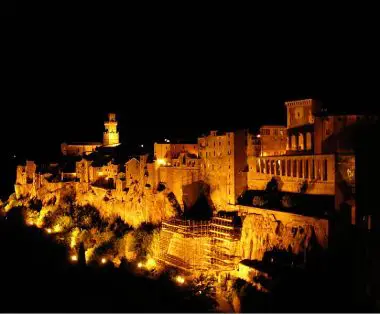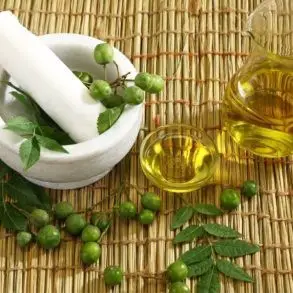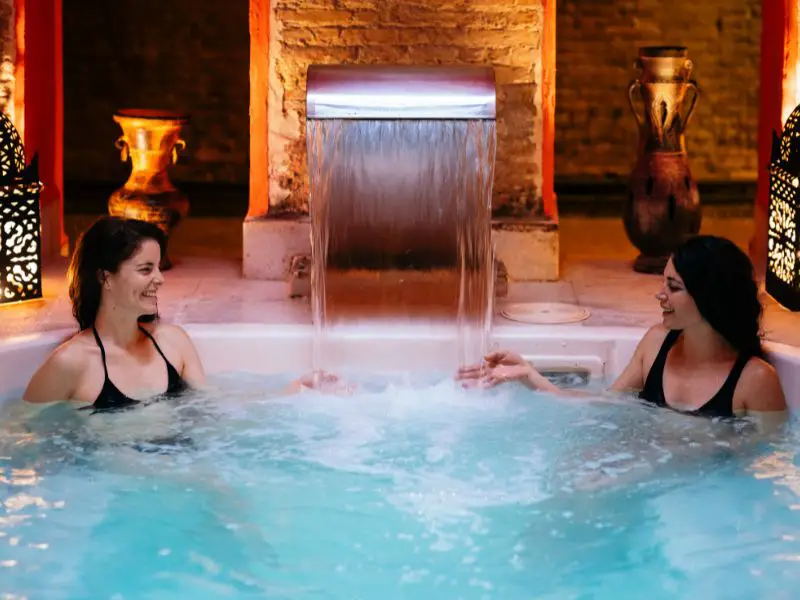
From the cultural hubs of Istanbul and Bursa to the natural wonder of Pamukkale, the journey through Turkey Hot Springs & Hammams is nothing short of a symphony – each note, each stop, contributing to a harmonious blend of history, culture, and natural wellness.
A visit to Turkey offers many enthralling experiences, a blend of its illustrious past, dynamic cultures, and breathtaking natural beauty. Turkey is a treasure mine of sights and feelings, from the bustling bazaars of Istanbul to the rock formations of Cappadocia, the blue waters of the Aegean, to the snow-capped peaks of the Kackar Mountains.
However, the custom of unwinding and rejuvenating in hammams and hot springs is tucked away among the nation’s varied attractions and represents a distinct enjoyment. Since the Roman and Ottoman times, these serene areas have served as places for social gatherings and healing retreats.
They still offer a peaceful escape from the hectic pace of modern life and a palpable link to the past. Thus, let’s set off on a voyage beyond mere relaxation and explore Turkey’s timeless rituals. This journey offers physical relaxation and spiritual and cultural immersion into the core of Turkey’s traditions.
Immersing oneself in Turkey’s wellness tradition requires some planning, especially for international travelers. So, the first step is obtaining a Turkey visa, a process that has been simplified with online applications.
In this guide, we list the main and best-preserved Turkish baths and Turkey hot springs not to be missed. But first, a bit of history.
Note: the main distinction between a Turkish bath and a hot spring is that the former does not necessarily have to be fed by a natural geothermal source. Anyways, it often happens that the two things coincide and therefore a natural source feeds a hammam.
Turkish Hammams, a Bit of History
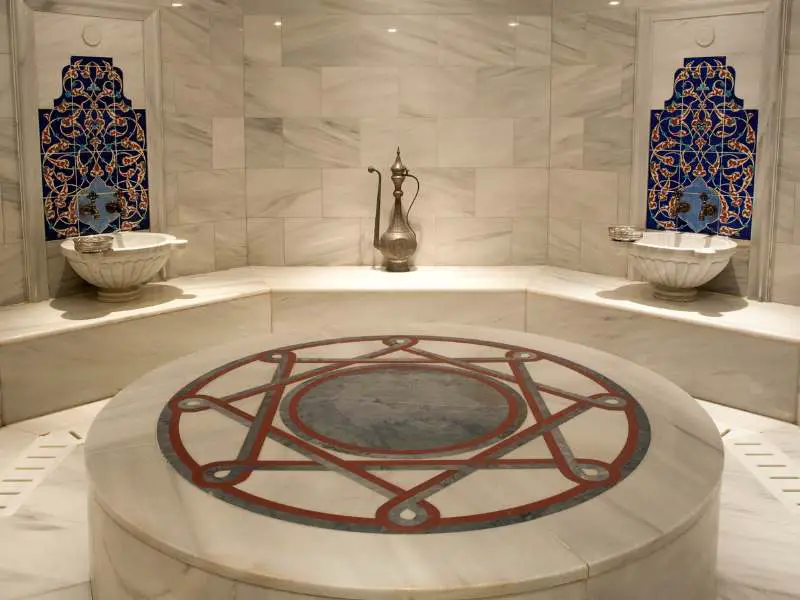
The history of hammams (Turkish baths) in Turkey is rich and spans many centuries. The concept of communal bathing dates back to ancient civilizations. In the Roman and Byzantine periods, public bathhouses were common, and these practices were adopted and transformed by the Ottomans. Byzantine Constantinople (modern-day Istanbul) had a complex network of bathhouses that served both practical and social purposes.
The Ottoman Turks, who established their empire in the late 13th century, continued and refined the bathing traditions inherited from earlier civilizations. They incorporated elements from their own culture, religious beliefs, and architecture into the design and operation of hammams.
The Ottomans elevated the design and architecture of hammams, creating intricate and beautifully decorated structures. Hammams typically featured a series of interconnected rooms with different temperatures: cold, warm, and hot rooms. They often incorporated domes, ornate tiles, and marble, showcasing the Ottomans’ skill in architectural aesthetics.
Hammams served both hygienic and social purposes. In a time when private bathing facilities were rare, hammams provided a way for people to cleanse themselves thoroughly. They also became social hubs where people of all backgrounds could interact, converse, and relax. It was not uncommon for discussions, negotiations, and even cultural events to take place in the hammams.
Its integration of social interaction, architecture, and a commitment to holistic healing became a crucial institution in Ottoman culture. Today’s hammam symbolizes Turkey’s wellness culture, maintaining its historical significance while adjusting to modern demands for relaxation and health. The hammam isn’t just a place for cleanliness; it’s also a cultural heaven that embodies the best of Turkish living and well-being.
Often built near mosques, they were serving a practical purpose for Muslims who needed to cleanse themselves before prayer. Ritual purification (wudu) is an essential aspect of Islamic practice, and hammams provided a suitable place for this cleansing.
As modern plumbing and private bathrooms became more common in the 20th century, the traditional role of hammams as places for hygiene and socialization diminished. Many historic hammams fell into disrepair or were repurposed.
In recent decades, there has been a renewed interest in preserving and restoring historic hammams. Some have been renovated and reopened to the public, both as cultural attractions and functioning bathing facilities. Tourists and locals alike seek the authentic experience of visiting these historic sites.
Today, hammams continue to be an integral part of Turkish culture and a unique experience for visitors. Whether seeking relaxation, cultural immersion, or a glimpse into history, visiting a Turkish hammam can provide insights into the country’s bathing traditions and architectural splendor.
A hammam, or Turkish bath, represents Turkey’s rich cultural legacy. It is a place where the physical and the spiritual come together to cleanse the body and the soul. The Ottomans inherited and sophisticatedly improved this Roman-era public bathing by adding components of Islamic ritual purification.
1. The Cemberlitas Hammam: A Portal to the Ottoman Era
The best hamam in Istanbul

In the heart of Istanbul, the Cemberlitas Hammam is a grand testament to Turkey’s hammam culture. Commissioned by Nurbanu Sultan, the mother of Sultan Murad III, in 1584, its historic walls echo stories of the Ottoman era.
The hammam’s architecture is characterized by its impressive domes, intricate tilework, and elegant design elements. The exterior and interior are adorned with decorative tiles, and the structure showcases the classic Ottoman design principles of symmetry and harmony.
Over the centuries, Cemberlitas Hammam has undergone several restoration efforts to preserve its historical significance. Today, it continues to operate as a functioning Turkish bath, offering both locals and tourists the chance to experience a traditional hammam ritual in a historic setting.
The traditional hammam experience starts in the warm room, or ‘hararet,’ followed by a soothing soap massage and concludes with a relaxing rest in the ‘soğukluk‘ or cooling room. It’s not just a bath but a ritual – a purifying journey that intertwines with history.
Visit the official website for opening hours, services and bookings.
2. The Healing Springs of Bursa
Home of many historical thermal baths and hammams

The city of Bursa, renowned for its historically significant hammams, also boasts a plethora of hot springs known for their healing properties.
Eski Kaplıca is one of the most famous thermal baths in Bursa. It dates back to the Roman era and has been used for centuries for its therapeutic properties.
During the Ottoman period, rulers and citizens alike valued the therapeutic effects of thermal waters. Bursa was the first capital of the Ottoman Empire, and this historical connection adds to the cultural and architectural significance of its thermal baths.
The bath complex reflects the Ottoman architectural style and offers visitors the opportunity to experience traditional Turkish bath rituals.
Çekirge is another district in Bursa known for its thermal baths. Locals believe these waters have curative properties, particularly beneficial for those with rheumatic diseases, but also soothing muscles and joints, improving circulation, and relieving stress. Many visitors come to Bursa to experience the relaxing and rejuvenating effects of the thermal waters.
3. The Historic Hamam in Antalya
Demirhan Hamam, and other Ottoman-era hammams
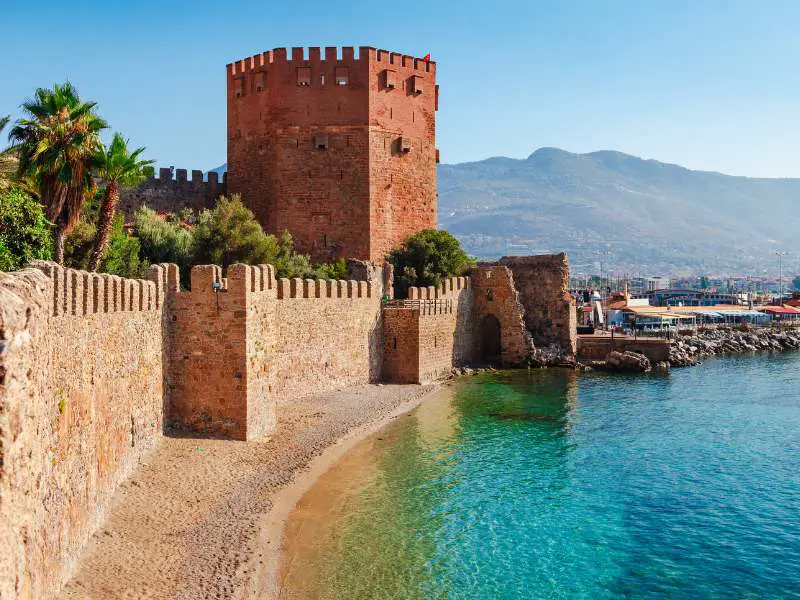
The bustling city of Antalya, famed for its picturesque beaches, also houses the historic Demirhan Hamam. Nestled in the city’s historic district, this hammam offers a traditional Turkish bath experience amid Antalya’s vibrant ambiance. Following your rejuvenating bath, stroll around the Old Town, admiring the charming Ottoman-era houses, making the hammam visit an essential part of your Antalya itinerary.
The Sefa Hamam, located in the heart of Antalya’s old town (Kaleiçi), is one of the oldest and most well-preserved Ottoman-era hammams in the city. The Hammam has been beautifully restored and is still operational today. It’s not only a historic site but also a place where visitors can experience the traditional Turkish bath culture.
Tip: Gastronomy Break – Nourishing the Body the Turkish Way

Following a relaxing hammam session, locals enjoy revitalizing meals. A bowl of ‘Kelle paça‘, a nourishing soup made from lamb’s head and feet, or ‘boza,’ a traditional fermented beverage, usually follows the bath or it is enjoyed by many as a winter treat.
Boza is primarily made from fermented grains, usually millet, but sometimes wheat or barley. The grains are soaked, cooked, and then fermented with the help of naturally occurring lactic acid bacteria. The result is a thick, slightly tangy, and mildly alcoholic beverage.
As part of your hammam experience, sampling these conventional foods is highly recommended, adding another layer of authenticity to your Turkish journey.
Turkey Hot Springs and Thermal Baths
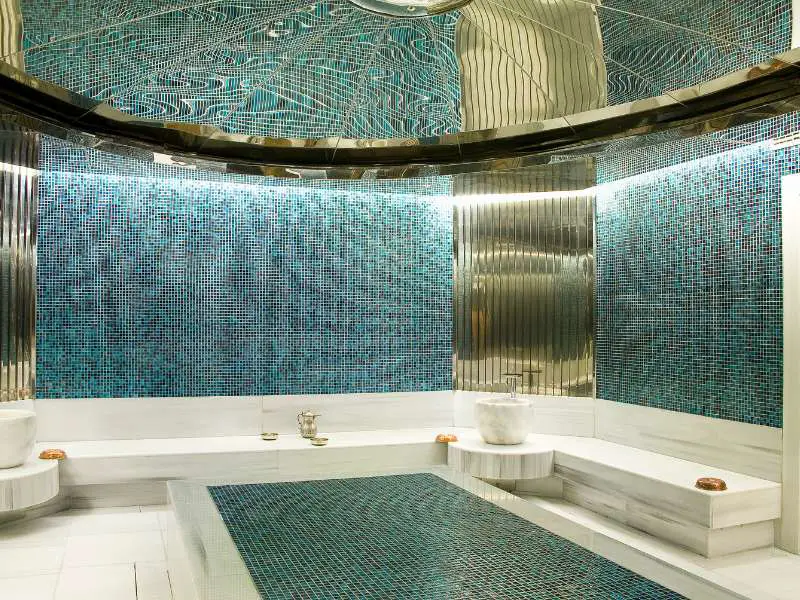
Balçova: An Ancient Bathing Tradition Revived
Balçova is a destination replete with thermal facilities that promise an unforgettable wellness journey in the western province of Izmir. Balçova has been a center of hydrotherapy since Roman times, with bathers drawn to the healing properties of its thermal waters.
The modern-day Balçova Thermal Baths on the ancient Agamemnon Thermal Springs site is a fantastic fusion of this old-world charm and contemporary amenities.
The thermal water here, emerging from the ground at a soothing 63°C, is believed to help with various health issues such as circulatory problems, rheumatic diseases, and skin conditions.
After a session at the thermal baths, you can enjoy a refreshing walk in the surrounding Thermal Park, taking in the views of Izmir Bay and breathing in the fresh air laden with the scent of the nearby pine forests.
Afyonkarahisar: Wellness in the Shadow of an Ancient Fortress

In western Anatolia, Afyonkarahisar, often referred to as Afyon, is another wellness destination worth exploring. This city, nestled at the foot of a massive rock formation topped by a Byzantine-era fortress, offers a range of thermal resorts known for their healing waters.
The Gazlıgöl Basin, to the west of the city, is renowned for its hot springs, which have temperatures between 40 and 60 degrees Celsius. These mineral-rich springs, abundant in calcium and magnesium, provide therapeutic advantages for several illnesses.
The combination of these healing waters, the city’s striking landscape, and its wealth of historical sites, including the ancient Phrygian Valley, makes Afyonkarahisar a multi-faceted gem on the Turkish wellness map.
Yalova: Hot Springs and More
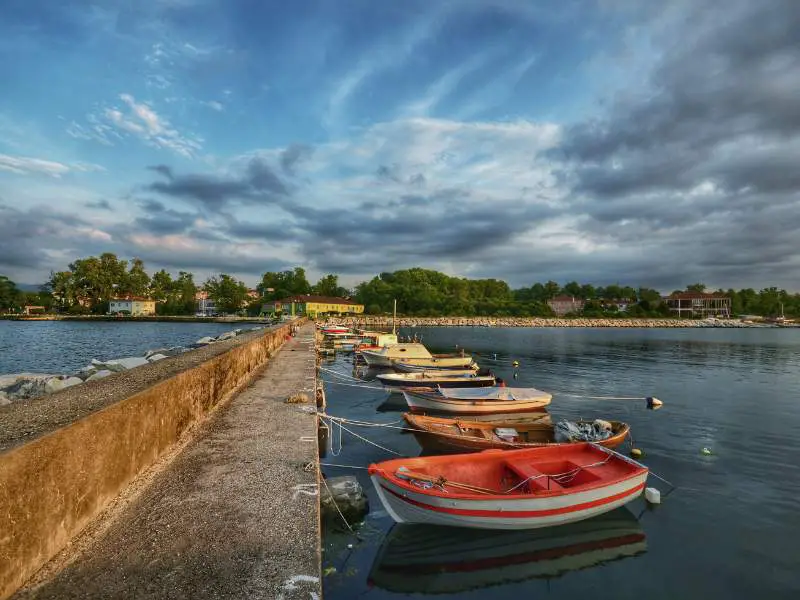
Just a short ferry ride from Istanbul, Yalova offers a retreat into nature’s lap with its lush forests, gorgeous sea views, and famed hot springs. The thermal baths of Termal, located about 12 km from Yalova city center, are the main wellness attraction here. They were popular even during the Ottoman era, with the elegant Sultan’s Mansion as an enduring reminder of the city’s historic allure.
Alongside the thermal baths, Yalova is home to the Yalova Atatürk Mansion, an important cultural monument, and the Karaca Arboretum, showcasing diverse plant species. Therefore, visiting Yalova offers wellness and a broader cultural and natural experience, making it an essential stop on your Turkish journey.
Pamukkale: Nature’s Own Spa

Pamukkale, meaning “Cotton Castle” in Turkish, is a stunning natural thermal spring and travertine terraces located in southwestern Turkey. It is a UNESCO World Heritage Site and a popular tourist destination known for its unique beauty and historical significance.
Pamukkale’s terraces are formed by the flow of calcium-rich thermal waters that have created white, mineral-rich deposits over centuries. The terraces look like white, cotton-like cascades, giving the site its name. The thermal waters at Pamukkale have a high mineral content due to their journey through the earth’s crust.
Adjacent to Pamukkale is the ancient city of Hierapolis, which was founded as a thermal spa in the 2nd century BCE. The thermal waters of Pamukkale were used for therapeutic and relaxation purposes by the inhabitants of Hierapolis and visitors from afar. The city is now in ruins but offers a glimpse into its historical significance.
Visitors to Pamukkale can enjoy the natural terraces, walk barefoot on the mineral-rich formations, and even wade in certain designated areas. However, in recent years, access to the terraces has been restricted to protect the fragile environment, and swimming in the terraces themselves is generally not allowed. There is a designated pool called Cleopatra’s Pool where visitors can swim; it is located within the Hierapolis ruins and contains warm thermal water.
Karahayit: Red Waters and Healing Mud
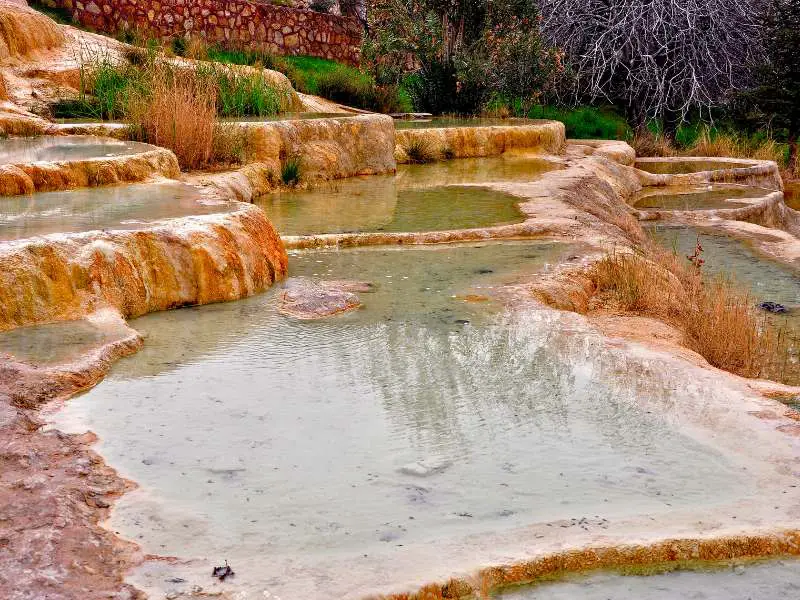
A short distance from Pamukkale, the hot springs of Karahayit offer another unique wellness experience.
Karahayit is a region in Turkey known for its unique and colorful hot springs. Located near the town of Denizli, it offers a distinctive hot spring experience that’s different from the more famous Pamukkale travertine terraces.
The waters here are reddish due to the high iron mineral content. Karahayit is renowned for its healing mud baths along with the hot springs.
Karahayit has developed over time to accommodate visitors who want to enjoy the hot springs. There are various thermal hotels and spa resorts in the area that offer accommodations, wellness treatments, and bathing facilities. Some of these establishments have designed their pools using natural hot spring water.
The Thermal Delight of Sivas: Kangal Fish Springs

For a unique relaxation experience, Kangal Fish Springs in the Sivas province offers a genuinely distinctive encounter. Here, the hot spring waters teem with tiny fish known for their skin-healing properties. The fish gently nibble at your skin as you immerse in these warm waters, providing a natural exfoliation treatment. It’s an unorthodox yet surprisingly relaxing therapy, adding an exotic touch to your Turkish wellness journey.
The effectiveness of this treatment against psoriasis has been studied on 87 patients with psoriasis vulgaris and the patients were evaluated by a dermatologist for 21 days.
Conclusion
While Turkey is home to numerous historic hammams and hot springs, the country’s modern wellness tourism industry has flourished. Luxurious spa resorts, particularly in areas like Antalya and Bodrum, offer a fusion of traditional Turkish rituals and contemporary spa therapies. These resorts provide the best of both worlds for those seeking relaxation and pampering.
The essence of Turkey’s relaxation rituals lies in the symbiosis of nature and culture. Whether it’s the architectural grandeur of hammams or the therapeutic allure of hot springs, every experience is deeply rooted in Turkey’s rich history and natural bounty. These practices are not merely about rejuvenation but provide a gateway to understanding the country’s cultural nuances.
From the cultural hubs of Istanbul and Bursa to the natural wonder of Pamukkale, the journey through Turkey’s ancient relaxation rituals is nothing short of a symphony – each note, each stop, contributing to a harmonious blend of history, culture, and natural wellness.
These age-old rituals, practiced and preserved over centuries, offer a unique perspective on Turkish culture and a profoundly personal experience. This exploration leaves you with a rejuvenated body and mind and a slice of Turkey’s rich heritage that resonates long after the journey ends.
More Hot Springs in Europe?
- Budapest Hot Springs, the 10 Best Thermal Baths in the City
- Slovenia Hot Springs – The 7 Best Thermal Spas [2023]
- The Most Beautiful Hot Springs in Tuscany – Natural Baths + Luxury SPA




